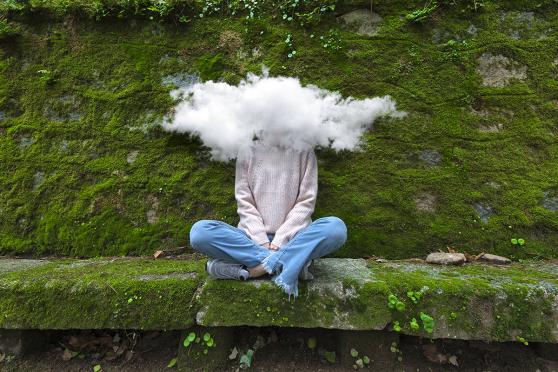Why Feeling Sad Isn’t a Normal Part of Getting Older
There’s a difference between occasional sadness and depression. Learn how to tell them apart and how to start feeling happier today.

Seeing our children and grandchildren grow. Living out lifelong dreams in retirement. There are many reasons to feel joy in our older years. But with all the changes happening as we age, it’s okay — and normal — to feel sad sometimes too.
“As we grow older, many of us struggle with isolation and loneliness,” explains Frank Sileo, PhD. Sileo is a licensed psychologist and founder and executive director of The Center for Psychological Enhancement. “Or maybe you’ve entered into retirement without a plan and feel unproductive.”
Stephania Sciamano, a retired naturopathic doctor, shares that idea. “There are so many kinds of losses that older people experience. Like friends or family passing or the loss of sight and hearing,” she explains. “Oftentimes, there is a loss of what you thought your life was going to look like that can contribute to depression.”
No matter what the reason, one thing holds true: Although occasional sadness is normal for everyone, young and old, depression is not a normal part of aging. In fact, some research suggests that people tend to get happier as they get older. That’s mainly because it becomes easier to control emotions. Translation: Less drama, more delight.
But if you are feeling down, how can you tell if it’s everyday sadness or depression? Let’s take a closer look.
Am I depressed ... or just sad?
Depression has some telltale symptoms, including:
- Loss of interest in something you used to love (say, knitting or golf).
- Weight loss or loss of appetite, or a rise in appetite and weight gain.
- Trouble sleeping, or sleeping too much.
- A lack of energy and motivation.
- Trouble remembering things, making decisions, and staying focused.
- Unexplained aches or pains.
- Feelings of worthlessness, guilt, or self-blame.
- Irritability, frustration, or anger — even over little things.
- A general feeling of despair.
If you have at least one of these symptoms, that doesn’t always mean it’s depression. It depends on how long the symptoms last. A few days of low motivation is normal. A few weeks? Then it’s starting to be a problem, according to the National Institute on Aging (NIA).
What’s more, other conditions share some of the same symptoms as depression. “A fuzzy memory might not be depression. It could be a symptom of an illness,” Sileo says. For example, older adults who have depression for the first time later in life may be suffering from restricted blood flow. Also called ischemia, it causes blood vessels to stiffen. That stops blood from flowing properly to the brain. When that happens, it can cause “vascular depression.”
Depression is also more likely to happen along with other medical issues, the NIA adds. Conditions like diabetes, heart disease, and Parkinson’s disease have strong connections with depression. Medications for those conditions may also raise the risk of depression.
If symptoms like the ones above have been going on for a few weeks, talk to your doctor. They can help you figure out if there is something else at play. And they can work with you to find solutions.
If you’re having thoughts about self-harm, get help right away: Call your doctor, the National Suicide Prevention Lifeline (988), or 911. The person you talk to will be ready and willing to help, so follow their advice.
If you think you might be depressed, BlueForMe, your digital health management tool, can help. This no-cost app comes with your health plan, and it can connect you with your care team and mental health support. Call 844-730-2583 to see if you’re eligible for BlueForMe today.
7 ways to start feeling happier today
It’s important to get medical help for depression. But there are some ways to lighten your mental load at the same time. If you’re just feeling blue, these tips can help brighten your mood too, suggest both Sileo and Sciamano.
1. Seek out new experiences
“Studies show that the brain responds well to new things,” Sciamano says. That “new” doesn’t need to be something drastic. A few ideas to get you started:
- Take a long walk with a friend on a new route.
- Make new friends at a card-playing group.
- Browse a new section of the library or bookstore.
- Watch a different kind of TV show or movie than you usually do.
- Take an in-person or online class to learn a new skill or express your creativity.
2. Play like a child
“It sounds simple, but the happiest people you meet are often the most playful,” says Sciamano. Whether it’s games with your grandchildren or dancing around in your kitchen to a favorite song, tap into the power of play.
3. Share your favorite hobby
“Being with others who share a common interest can go a long way in terms of alleviating feelings of sadness,” says Sileo. Doing activities together can be especially meaningful. That might be volunteering, playing music, or working on crafts.
4. Connect to nature
Nature is so powerful that it can even change how our brains work. It doesn’t take much time outside to get a mental health boost. Just 2 hours a week is enough to see positive changes, according to a study in Scientific Reports. Walk to a nearby park with a friend. Take up gardening. Or just spend some time soaking up the sunshine.
5. Change what you eat
Most of your “feel-good” hormone, serotonin, is made in the digestive tract. That means gut health is key for mood regulation. Choose gut-healthy foods that are high in fiber, such as:
- Raspberries
- Blackberries
- Legumes like chickpeas and lentils
- Broccoli
And try to limit sugary drinks, alcohol, and red meat.
6. Work up a sweat
Physical exercise releases endorphins that can lift your mood. It works so well, even in small doses, that an article published by the American Psychological Association suggests that therapists should prescribe more fitness. Plus, group fitness classes at a local senior center or fitness center can be a great way to make new friends and ease loneliness.
7. Talk it out
According to Sileo, finding support will be your best bet to ease feelings of sadness. A 2020 study noted that social connections could be among the strongest protections against developing depression. “I suggest to my patients that they get connected,” Sileo explains. “Join a senior group. Volunteer at a school, hospital, or library. Simply interacting with others can go a long way.”
Trying to overcome depression can feel hard, but you don’t have to go it alone. BlueForMe, your health management app, gives you access to programs for managing depression, anxiety, stress, and more. Call 844-730-2583 to see if you’re eligible for BlueForMe today.
SOURCES:
[1] Li J, Lai DW, Chappell NL. “The Older, the Happier?: A Cross-Sectional Study on the “Paradox of Aging” in China.” Research on Aging, 2021.
[2] “Depression (Major Depressive Disorder).” Mayo Clinic, www.mayoclinic.org/diseases-conditions/depression/symptoms-causes/syc-20356007. Accessed July 20, 2021.
[3] “Depression and Older Adults.” National Institute on Aging, nia.nih.gov/health/depression-and-older-adults. Accessed July 20, 2021.
[4] Salo KI, Scharfen J, Wilden ID, et al. “Confining the Concept of Vascular Depression to Late-Onset Depression: A Meta-Analysis of MRI-Defined Hyperintensity Burden in Major Depressive Disorder and Bipolar Disorder.” Frontiers in Psychology, 2019. Accessed July 20, 2021.
[5] Pearson DG, Craig T. “The great outdoors? Exploring the mental health benefits of natural environments.” Frontiers in Psychology, vol. 5, 2014, pp. 1178.
[6] White MP, Alcock I, Grellier J, et al. “Spending at least 120 minutes a week in nature is associated with good health and wellbeing.” Scientific Reports, vol. 9, 2019.
[7] Carpenter, S. “That Gut Feeling.” Monitor on Psychology, vol. 43, no. 8, 2021, pp: 50. Accessed July 20, 2021.
[8] Weir K. “The Exercise Effect.” Monitor on Psychology, vol. 42, no. 11, 2011, pp: 48. Accessed July 20, 2021.
[9] Choi KW, Stein MB, Nishimi KM, et al. “An Exposure-Wide and Mendelian Randomization Approach to Identifying Modifiable Factors for the Prevention of Depression.” The American Journal of Psychiatry, vol. 177, no. 10, 2020, pp: 944-954. Accessed July 20, 2021.
DISCLAIMER: Florida Blue has entered into an arrangement with Wellframe to provide members with care decision support services, information and other services. This article is provided by Linkwell Health through their arrangement with Wellframe. Please remember that all decisions that require or pertain to independent professional medical/clinical judgment or training, or the need for medical services, are solely your responsibility and the responsibility of your physicians and other healthcare providers. Wellframe is an independent company that provides online services to Florida Blue members through the Blue for Me app.

